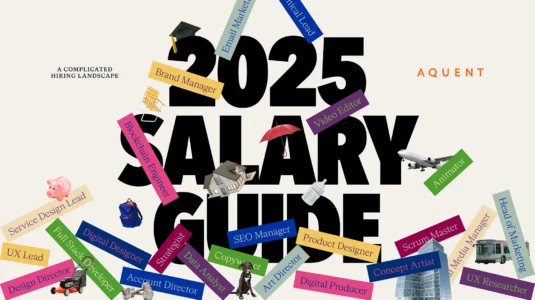

Key Takeaways
- The success of organizations in the dynamic work landscape of 2024 hinges on high performing teams and competitive compensation.
- To attract and retain top talent, organizations must offer compelling compensation packages that reflect their value.
- Location plays a significant role in salary gaps and market trends. Companies are finding success in hiring from lower-cost regions while offering competitive pay.
- Remote work has become a defining feature of the post-pandemic era, broadening the talent pool and extending operational hours for certain roles.
- Gender pay parity is still a pressing issue, with women in marketing, creative, and design roles earning only 90% of what men do.
Listen: Maximizing your team performance with competitive salaries.
As we navigate the landscape of work in 2024, two factors stand out as pivotal for success: high performing teams and competitive compensation. High performing teams, the bedrock of any successful organization, drive innovation and provide a competitive edge in today's evolving business environment. However, to attract and retain such top-tier talent, organizations must offer compelling compensation packages that reflect their value.
Understanding and setting competitive salaries is a complex task. It requires a thorough grasp of market trends, industry norms, and the impact of location on pay scales. Salaries often mirror the cost of living in a given area, contributing to a widening salary gap between different positions and regions. Aquent's Salary Guide proves indispensable in navigating these complexities. Offering comprehensive data on salaries across various professions and locations, it aids employers in setting competitive wages to foster characteristics of high performing teams.
Insights from the 2024 Salary Guide
When it comes to talent acquisition and retention, having reliable and comprehensive data at your fingertips can make all the difference. That's why we're excited to introduce our 2024 Salary Guide—the culmination of a year's worth of data collected from over 21,000 professionals representing nearly 100 job titles across the U.S. and Canada. Packed with data highlighting the latest compensation trends and strategies, this resource is a must-have for any organization seeking to attract and keep top performers.
What makes our 2024 Salary Guide truly unique is that it's actionable. We don't just present raw data. We translate the data into talent insights you can use to refine your recruitment and retention strategy, from developing competitive job offers for specific roles and locations to closing the gender wage gap to understanding the going rate for emerging roles. So, if you're looking to gain a competitive edge in the talent market, our guide on attracting and retaining high performers is the resource you need.
Location matters: Market trends and hidden talent pools
With the rise of the hybrid model that combines remote and in-person work, the location you choose to work from is now as important as ever for your compensation. Our data shows some interesting trends when it comes to salaries in different cities.
First off, salaries in City Group 1 (New York, San Francisco, and Silicon Valley) have seen a significant increase of 5.5%. That's more than double the salary growth in other city groups. The difference in salaries between the lowest and highest cost-of-living city groups has also increased to a staggering 27.5%, or $28,000. Last year, it was 24.5% or $24,000. This proves that higher-cost markets demand higher salaries.
However, the shifting landscape of work has resulted in some interesting changes. Certain roles, like Design Directors, Product Designers with over five years of experience, and Digital Producers, have seen double-digit salary growth in certain cities. This means they might be more likely to switch jobs for better pay. On the other hand, roles like Production Artists, Copywriters with over five years of experience, and Marketing Managers, where AI is becoming more prevalent, have not seen much salary growth. These employees could benefit from upskilling programs to learn how to use AI for routine tasks. This would free up their time for more strategic work and potentially lead to higher-paid roles.
Unfortunately, salaries for Creative Directors, UX Designers, and Graphic Designers with over five years of experience have actually decreased in some cities. As market pay falls, it's crucial for employers to prioritize pay equity and avoid creating wage disparities, especially among marginalized groups.
In today's competitive business environment, companies are finding that strategic talent acquisition from lower-cost-of-living areas is a smart cost-management strategy. By hiring skilled professionals from these regions, companies can offer competitive salaries that attract top talent while reducing overall costs. This approach also improves employees' quality of life and job satisfaction, especially when remote work options are available. By leveraging data on talent availability across different regions, employers can make informed decisions about hiring and promoting career growth opportunities. Ultimately, this win-win approach helps companies save money, foster innovation, and stay competitive.
The emergence of remote work: A new era in the workplace
The post-pandemic era has witnessed a seismic shift in work arrangements, with remote work becoming a defining feature. According to Aquent's Talent Insights Report, high performing teams are increasingly likely to be remote, challenging traditional notions of productivity and collaboration.
Historically, over 90% of employees lived within commuting distance of their workplaces, underlining the importance of location. However, the rise of remote work has altered this dynamic. It has broadened the talent pool, enabling companies to hire from diverse backgrounds and geographic locations. This “follow-the-sun” model also extends operational hours, particularly beneficial for roles like Social Media Managers and communication professionals who need to stay abreast of trending topics throughout the business day across time zones.
Remote work offers numerous advantages, with flexibility as a crowd-pleasing standout. Recent studies indicate that employees value flexibility so much that they are willing to take pay cuts for it. One study showed that employees were willing to accept an 8% pay cut for increased flexibility. Similarly, a survey found that two-thirds of employees would trade a portion of their salary for more job flexibility, with women valuing flexibility more than men.
The emergence of remote work is reshaping the world of work at an unprecedented pace. From the rise of AI and immersive technology to the debates about remote versus in-office work, these changes are creating new opportunities and challenges for both employers and employees. As we navigate this new landscape, understanding and adapting to these trends will be key to success in the evolving workplace.
Pay gap: A persistent issue in marketing, creative, and design roles
Despite strides toward gender equality, women in marketing, creative, and design roles continue to earn only 90% of what their male counterparts do. What's more concerning is that the gap is widening for many roles rather than narrowing. This pay inequity is influenced by several factors, including negotiation difficulties, reluctance to switch companies, the “mommy track” stigma, and the cost of flexibility.
Achieving gender pay parity is not just a matter of creating an inclusive and equitable workplace; it's also about boosting team performance. Research has shown that teams with greater gender diversity perform better, and it stands to reason that high performing employees should be paid equally, regardless of their gender.
Regrettably, the trends in our industry are moving in the wrong direction. This year, pay disparity has expanded in many roles. Women in positions like Design Director, Creative Director, and Digital Project Manager received significantly less pay than men, with gaps of -22.2%, -18.9%, and -15.5%, respectively—worse than the previous year.
Female Associate Creative Directors and Production Artists, who were almost at pay parity last year, earned 13.4% and 15.5% less than their male colleagues this year. Furthermore, in some roles where women outearned men last year, the trend has reversed this year, affecting Marketing Managers, UX Leads, Graphic Designers, and Digital Designers.
These disparities may be attributed to negotiation hurdles, as hesitance to negotiate can lead to lower initial salaries and fewer pay raises. Reluctance to change companies can also hinder opportunities for increased compensation and bonuses. The “mommy track” stigma, where requests for flexible or remote work schedules are interpreted as decreased dedication, can also hinder career progression. Finally, the cost of flexibility is another factor, with employees willing to take pay cuts for flexibility, a trend more common in women.
Addressing the gender pay gap is an urgent issue that requires immediate attention. As an industry, we need to actively work toward creating equitable workplaces where all employees are valued and compensated fairly.
Conclusion
In today's rapidly changing work environment, businesses are evolving their strategies to attract and retain top talent. As our reports highlight, the success and growth of any business hinge on building high performing teams and offering competitive pay. The rise of remote work and its inherent flexibility has broadened the talent pool and reshaped our understanding of productivity and collaboration. However, with this evolution comes new challenges, including the cost of flexibility, which some employees are willing to bear in exchange for increased work-life balance.
Interestingly, our data reveals that when it comes to compensation, location still matters. Salaries have increased in higher-cost-of-living cities, creating a noteworthy difference compared to lower-cost areas. Yet, strategic talent acquisition from these lower-cost regions is emerging as a smart cost management strategy for companies, where they can attract top talent while saving costs and fostering innovation.
Regrettably, a persistent issue marring this progress is the widening gender pay gap, particularly noticeable in marketing, creative, and design roles. It is crucial to address these issues and strive for gender pay parity, enhancing team performance and creating an inclusive and equitable workplace.
Now is the time for action. Employers must adapt, consider changing preferences, and understand these trends to succeed in this evolving world of work. Let us strive to bridge the pay gap and foster a truly inclusive and equitable workplace. Every dollar counts toward building a successful team. Download the Aquent 2024 Salary Guide to see the data for yourself.
Related

Great brand collaborations are the best to strengthen identity.
Design & Experience, Insights & Trends, Marketing & Creative, Beauty and Fashion

Consumer demand and policy are driving EV market growth.
Development & Technology, Insights & Trends, Automotive

Are you missing opportunities to improve health screenings?
Design & Experience, Marketing & Creative, Health


